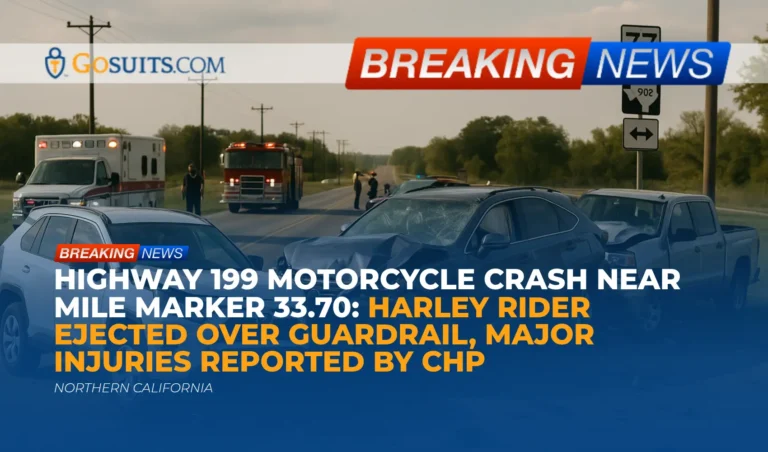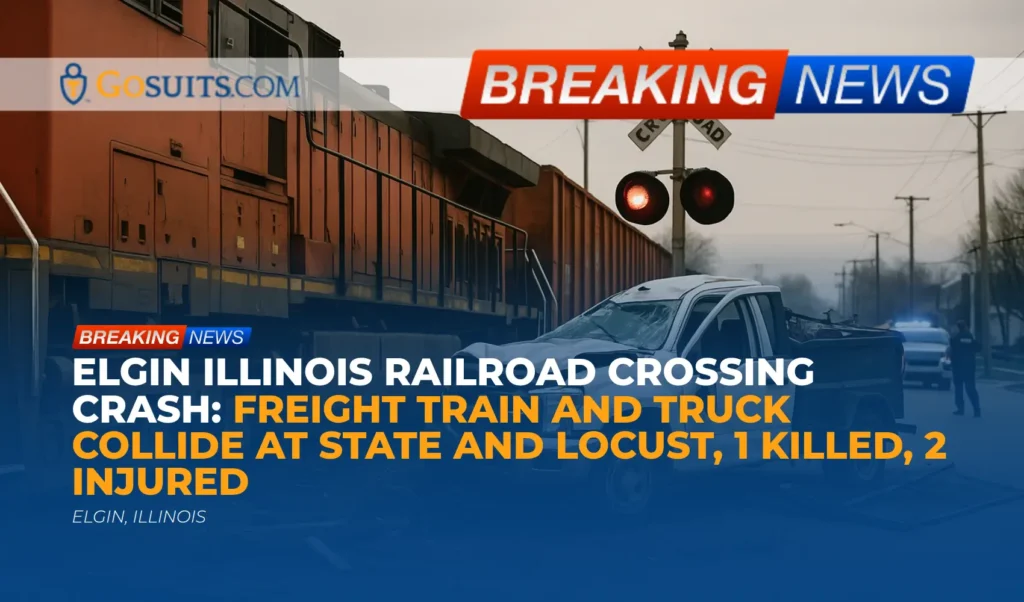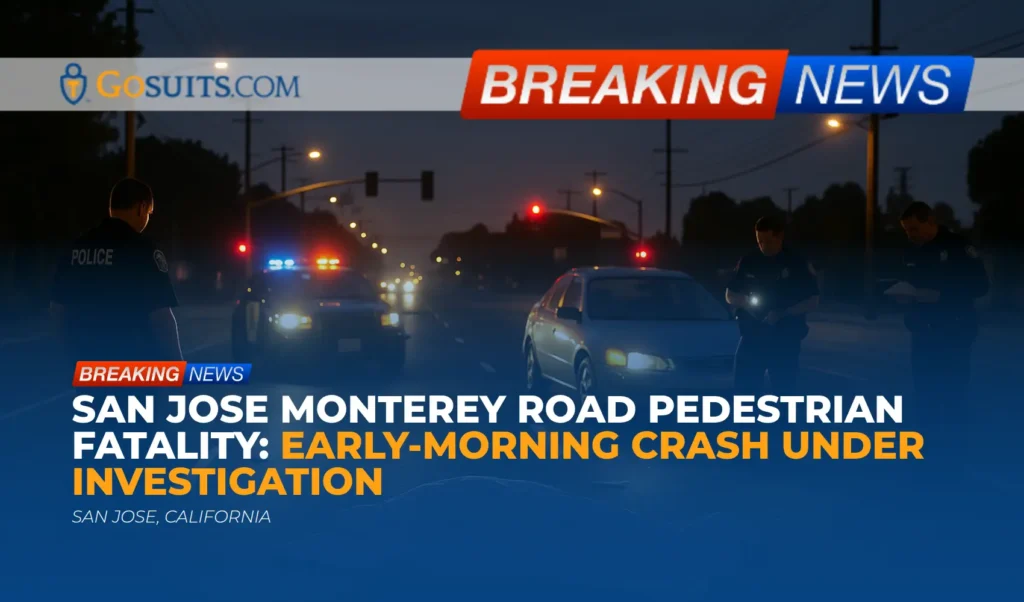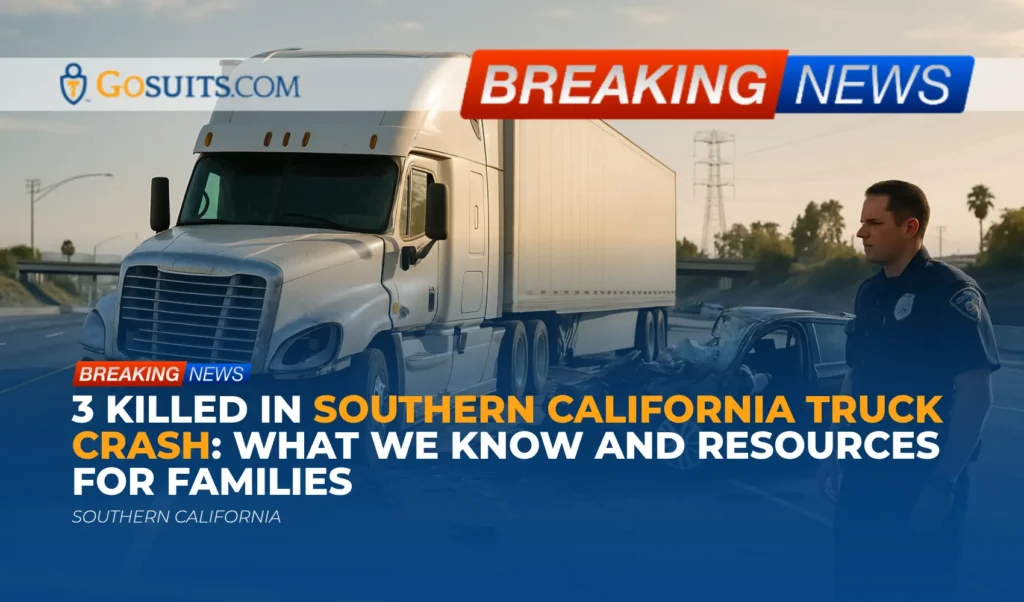- What We Know From Official Dispatch Updates
- Where the Incident Happened and Why That Location Matters
- Immediate Steps After a Major Injury Motorcycle Crash on a Highway
- How Police, Fire, and Medical Response Typically Unfold
- Getting Key Records: Collision Report, 911 Audio, Medical and Coroner Records
- Potential Civil Liability Considerations in a Single-Vehicle Guardrail Crash
- Insurance Issues Motorcyclists Commonly Face After a Serious Crash
- Preserving Evidence On and Around Highway 199
- Understanding Injuries in Over-Guardrail Motorcycle Ejections
- Community Safety Context: Motorcycle Risks and Helmets
- Timelines and Deadlines That Can Affect Civil Claims in California
- Support Resources and Public Agencies
- What Families Can Expect in the Weeks Following a Major Injury Crash
- Commentary from Gosuits Northern California Personal Injury Attorney
- Action Step: Why Taking Prompt, Informed Steps Matters Now
What We Know From Official Dispatch Updates
Based on California Highway Patrol dispatch updates shared on October 18, 2025, a major injury traffic collision occurred at approximately 4:44 p.m. on Highway 199 North, near mile marker 33.70. The rider of a Harley Davidson motorcycle struck a guardrail and went over it. The motorcycle came to rest in the southbound lane while the rider ended up in the northbound lane. Fire and medical personnel were notified and were en route. The CHP later categorized the incident as a major injury collision. A tow truck was requested for a Harley motorcycle with moderate front-end damage. A dispatch notation indicated the roadway remained open, with a line mentioning, “ENRT SUTTER FOR \ FU,” which is part of the log language.
The updates did not include identifying information about the rider, a detailed cause analysis, or confirmation of final medical status. No additional involved vehicles were referenced; the incident was described as a solo-vehicle collision.
Where the Incident Happened and Why That Location Matters
The crash was reported on Highway 199 North around mile marker 33.70, a highway that runs through Northern California. Highways like 199 include segments with curves, elevation changes, river corridors, and guardrails intended to prevent vehicles from leaving the roadway. The presence of a guardrail is relevant in any analysis of a motorcycle crash, because the way a rider interacts with a barrier can influence both the mechanism of injury and potential questions about speed, roadway condition, visibility, and barrier condition.
Highways managed by state agencies are subject to maintenance and inspection routines. If roadway conditions such as debris, potholes, oil, gravel, or worn pavement markings are later found to have contributed, that can influence civil fault analysis. However, at this time, there is no official statement about the cause, and any analysis should remain general until collision investigators complete their work.
Immediate Steps After a Major Injury Motorcycle Crash on a Highway
After a major injury collision, the priorities are safety, medical care, and documentation. Without speculating about this case, the following steps are generally appropriate in similar incidents:
- Ensure scene safety and get medical help. On highways, secondary collisions are a risk. Move to a safe location if possible and call 911.
- Follow emergency medical guidance. Motorcycle ejections can involve head, spine, or internal injuries. Avoid moving an injured person unless they are in immediate danger.
- Document the scene if it is safe. Photos of the motorcycle, guardrail, skid marks, roadway condition, lighting, and any debris can later help clarify what happened.
- Identify potential witnesses. Collect names and contact information from drivers or bystanders who saw the event or the roadway condition shortly before the crash.
- Request and retain records. The CHP collision report, medical records, and any related public records help establish a factual foundation. See how to request those in the “Getting Key Records” section below.
Families supporting an injured rider often face a difficult and confusing period. Keeping a timeline of what was said by responders, where transport occurred, and which agencies were involved can help later.
How Police, Fire, and Medical Response Typically Unfold
When a major injury collision is called in, dispatch can notify the CHP, local fire, and EMS. CHP officers may handle traffic control, scene safety, and reporting. Fire and EMS assess injuries and determine whether ground transport or air medical is appropriate depending on condition and distance to an appropriate hospital.
CHP collisions resulting in injuries often generate an official collision report that documents involved parties, vehicle descriptions, a preliminary diagram, and statements from those at the scene when possible. The report may be followed by supplemental narratives if investigation continues.
If an injured rider is transported, receiving hospitals create their own clinical records. In some instances, a patient may be stabilized at one facility and transferred to another for specialty care. Families can usually obtain medical records through the hospital’s health information management department. The federal right of access to medical records is recognized under HIPAA. See the U.S. Department of Health and Human Services guidance on individual access rights at HHS.gov.
Getting Key Records: Collision Report, 911 Audio, Medical and Coroner Records
CHP collision report
For collisions investigated by the California Highway Patrol, parties to the crash or their representatives can request a copy of the collision report from the CHP Area Office that handled the scene. Use the CHP office locator to find the correct office and inquire about the request process and any required forms: CHP Office Locator.
911 audio and dispatch logs
In some circumstances, 911 recordings and CAD logs may be obtainable through a California Public Records Act request, subject to exemptions for privacy and ongoing investigations. The California Public Records Act is codified at Government Code section 6250 and following, available at leginfo.legislature.ca.gov. Policies and availability can vary by agency, and response times and redactions are common.
Medical records
Patients, or their legal representatives, can request hospital records, imaging, and bills from the treating facilities. Federal guidance on your right to access medical records is available at HHS.gov.
Coroner and death certificate records
While this incident was described as a major injury event, families seeking records in cases involving a death typically communicate with the county coroner or medical examiner for autopsy and investigative reports. Certified copies of California death records can be requested through the California Department of Public Health’s Vital Records program at cdph.ca.gov.
Potential Civil Liability Considerations in a Single-Vehicle Guardrail Crash
Every collision has unique facts. Without speculating about the cause here, investigating a single-vehicle motorcycle crash that involves a guardrail often includes looking at the following:
- Roadway conditions such as gravel, oil, standing water, potholes, uneven pavement, or inadequate warning signs. Maintenance records and prior complaints can be relevant if a hazard is alleged. The California Department of Transportation accepts roadway maintenance reports through its customer service portal at dot.ca.gov.
- Guardrail placement and condition. Barrier type, terminal ends, installation height, damage, and maintenance history can be evaluated. The Federal Highway Administration provides background on motorcycle and roadside safety considerations at safety.fhwa.dot.gov.
- Visibility and lighting. Curves, shade transitions, sun glare, and low-light conditions can affect a rider’s line of sight and reaction distance.
- Vehicle factors. Tire condition, brakes, steering components, and any aftermarket modifications sometimes matter in a crash analysis.
- Human factors. Reaction time, avoidance maneuvers, and situational awareness are routinely assessed in any collision investigation.
In California, injury claims typically require proving that someone else’s negligence contributed to the harm. If a public entity’s roadway condition is alleged to be a cause, claims must comply with the Government Claims Act, which imposes a short timeline to present a claim before any civil filing. See Government Code section 911.2 regarding the general six-month claim presentation period at leginfo.legislature.ca.gov, and the California Government Claims Program overview at the Department of General Services at dgs.ca.gov.
If no public entity is involved, investigation may focus on a private party’s conduct or on third-party factors that contributed to the event. Because evidence on open highways can change quickly, prompt documentation is especially important.
Insurance Issues Motorcyclists Commonly Face After a Serious Crash
Motorcycle claims regularly involve more than one policy. Riders may encounter coverage questions that include liability, med-pay, and uninsured or underinsured motorist provisions. Each policy has specific notice and proof requirements.
- Reporting the crash to the state. California requires that traffic crashes resulting in injury, death, or property damage over a set amount be reported to the DMV within 10 days using the SR-1 form, regardless of fault or whether law enforcement responded. See the DMV guidance at dmv.ca.gov.
- Recorded statements. Insurers often ask for recorded statements soon after a crash. Statements can be used to limit or deny claims. It is prudent to consult an attorney first before speaking with any insurance carrier. What is said to an insurer can be used against the claimant later.
- Preserving the motorcycle. The bike can be critical evidence. Before authorizing disposal, consider preserving it for inspection.
- Medical bills and liens. Health insurers and certain public programs may assert reimbursement rights. Understanding these rights early helps avoid surprises at settlement time.
California is a fault-based state for auto collisions. Fault determinations can be complex, especially when the initial report lists a crash as single-vehicle. Witness accounts, physical evidence, and roadway conditions can shift the picture.

Preserving Evidence On and Around Highway 199
Evidence can change rapidly on a highway. Skid marks fade, debris is cleared, and weather can alter conditions. Consider the following steps in comparable situations:
- Photograph the scene promptly. Capture the guardrail from multiple angles, the roadway surface, posted signs, lighting conditions, and any vegetation that may affect visibility.
- Note mile markers and landmarks. Mile marker 33.70 is specific. Include this in any communications with agencies and when requesting records.
- Preserve the motorcycle and rider gear. Helmets, jackets, gloves, and boots often show impact points and abrasion that help explain mechanisms of injury.
- Identify public cameras if any exist. Some highways or nearby facilities may have cameras, though preservation is not guaranteed and retention periods are short.
- File a roadway condition report if a hazard is suspected. If a potential defect or hazard is observed, submit a maintenance request to the state using the Caltrans customer service request system at dot.ca.gov. Keep a copy of any submission and response.
Understanding Injuries in Over-Guardrail Motorcycle Ejections
Ejections over a guardrail can involve high-energy forces. Common injuries in comparable incidents may include head and neck trauma, spinal injuries, fractures, abdominal injuries, and internal bleeding. Even with a helmet, riders can suffer significant force transmission to the body. Immediate evaluation and appropriate imaging are important.
Follow-up care may include trauma surgery, orthopedics, neurology, rehabilitation medicine, and physical therapy. Keeping all discharge instructions, imaging discs, and visit summaries helps create a continuous record for both medical and legal needs.
Community Safety Context: Motorcycle Risks and Helmets
Motorcyclists face elevated risk compared to occupants of enclosed vehicles. The National Highway Traffic Safety Administration publishes data that consistently shows severe consequences for riders in highway crashes. NHTSA notes that wearing a DOT-compliant helmet is a key protective measure, with helmets estimated to reduce the risk of head injury by a significant margin and the risk of death by approximately 37 percent for riders. See NHTSA’s motorcycle safety information at nhtsa.gov.
California requires all motorcycle riders and passengers to wear helmets that meet federal standards. See California Vehicle Code section 27803 at leginfo.legislature.ca.gov. While helmet use cannot prevent every injury, compliance is essential and can be a factor in both safety and the way insurers evaluate claims.
Timelines and Deadlines That Can Affect Civil Claims in California
General personal injury limitations period
California’s statute of limitations for most personal injury actions is two years from the date of injury. See Code of Civil Procedure section 335.1 at leginfo.legislature.ca.gov. Exceptions can apply, and different rules can govern claims involving minors or delayed discovery of injury.
Claims involving public entities
If a public entity or employee is alleged to be involved due to roadway condition or other factors, the Government Claims Act generally requires presenting a written claim within six months. See Government Code section 911.2 at leginfo.legislature.ca.gov and the Department of General Services Government Claims Program at dgs.ca.gov. Missing this step can affect the ability to pursue a civil case later.
DMV reporting
Separate from any insurance claim, California requires an SR-1 report to the DMV within 10 days if the crash involved injury or certain property damage thresholds. See the DMV’s accident reporting page at dmv.ca.gov.
Support Resources and Public Agencies
After a serious highway crash, multiple agencies and offices may hold pieces of the record or be able to help:
- California Highway Patrol Area Office. To request the collision report or to ask procedural questions, use the CHP Office Locator to find the appropriate office that handled Highway 199 at the time of the crash. Ask about their collision report request process.
- Caltrans Maintenance. If you believe a roadway condition contributed, document it and submit a maintenance request through the Caltrans customer service system at dot.ca.gov.
- DMV reporting. Confirm whether an SR-1 needs to be filed. Instructions and forms are provided by the California DMV at dmv.ca.gov.
- Hospitals and EMS providers. Contact the treating hospital’s records department for medical records, imaging, and billing statements. Access rights are outlined by the U.S. Department of Health and Human Services at HHS.gov.
- Coroner and vital records. In the event a death is involved, the county coroner’s office maintains investigative records. Certified death records can be obtained through the California Department of Public Health’s Vital Records at cdph.ca.gov.
- Public records requests. For dispatch logs or related records, consider a California Public Records Act request. See Government Code section 6250 and following at leginfo.legislature.ca.gov.
What Families Can Expect in the Weeks Following a Major Injury Crash
The first few weeks are often the most difficult. Here is what commonly unfolds after a serious motorcycle crash on a state highway:
- Medical stabilization and follow-up. Initial trauma care may be followed by inpatient treatment, surgical interventions, and rehabilitation. Keep all discharge paperwork and follow-up appointments.
- Collision report availability. CHP collision reports often take days to weeks to become available. Request the report as soon as it is released, and consider asking the Area Office how to submit supplemental information if witnesses later come forward.
- Insurance contact. Insurance companies may call early to gather statements. It is prudent to consult an attorney first before giving any statements. Communications may be recorded and used to evaluate or limit claims.
- Property damage evaluation. Coordinate inspection and valuation of the motorcycle. Avoid authorizing disposal of the motorcycle or gear until you are sure all necessary inspections are complete.
- Expenses and documentation. Start a simple file to store medical bills, repair estimates, time off work notes, travel costs for medical visits, and any communication with insurers or agencies.

Commentary from Gosuits Northern California Personal Injury Attorney
Our thoughts are with the rider and anyone affected by the Highway 199 collision. A sudden highway ejection over a guardrail is traumatic, and it is natural to have more questions than answers right now. This information is shared for general educational purposes to help the community understand what records exist, what steps can protect evidence, and which timelines may matter in California.
From a civil injury perspective, an incident described as a solo motorcycle crash still warrants a careful, fact-driven review. The presence of a guardrail, the lane positions of the rider and the bike, and the time of day can guide investigators to examine roadway condition, signage, barrier condition, and any environmental factors that might have influenced the event. Until the official report and any supplemental findings are available, conclusions should be avoided.
In the period after a serious crash, insurance companies and large entities often move quickly. Adjusters may seek recorded statements, broad medical authorizations, or early settlements before the full scope of injuries and losses is known. This can take advantage of a person’s lack of familiarity with the process. Statements given early, especially under stress, can be used to challenge fault or reduce compensation later. Preserving the motorcycle and gear, securing the CHP report, and documenting medical care are basic steps that help level the playing field.
Obtaining a free consultation with a seasoned injury attorney can help individuals understand options without committing to any particular course. It can also help identify time-sensitive steps, such as the six-month claim presentation period when a public entity may be involved and the DMV’s 10-day reporting rule. Importantly, getting informed guidance before speaking with insurers can prevent missteps that are hard to undo later.
Action Step: Why Taking Prompt, Informed Steps Matters Now
The exact steps to take will depend on the facts, but acting promptly has practical benefits that are easy to overlook in a stressful time.
- Secure the official record. Identify the CHP Area Office responsible for the scene and ask how and when to request the collision report. Having the report number and the mile marker noted in the dispatch can speed things up.
- Preserve physical evidence. Keep the motorcycle, helmet, and riding gear intact until inspections are complete. Evidence helps clarify cause and injury mechanisms.
- Document injuries and care. Save discharge papers, imaging results, physician notes, and receipts. Consistent documentation supports both health recovery and any future claim.
- Consult before calling insurers. A brief consultation with an attorney before giving any recorded statement can help avoid admissions or misunderstandings. What is said to an insurer can be used later in ways that are not obvious at the time.
- Calendar deadlines. Note the DMV’s 10-day SR-1 reporting rule for qualifying collisions and the general two-year personal injury limitations period in California, with shorter timelines for claims involving public entities. Acting within these windows preserves options.
- Identify potential roadway issues early. If any hazard is suspected, take photographs and consider submitting a maintenance request to Caltrans. Early documentation helps ensure conditions are recorded before they change.
Taking these steps promptly can protect evidence, clarify rights, and reduce the risk of losing important options due to missed deadlines or early statements. Keeping a calm, organized approach in the first days and weeks can make a meaningful difference in how the aftermath is managed.






